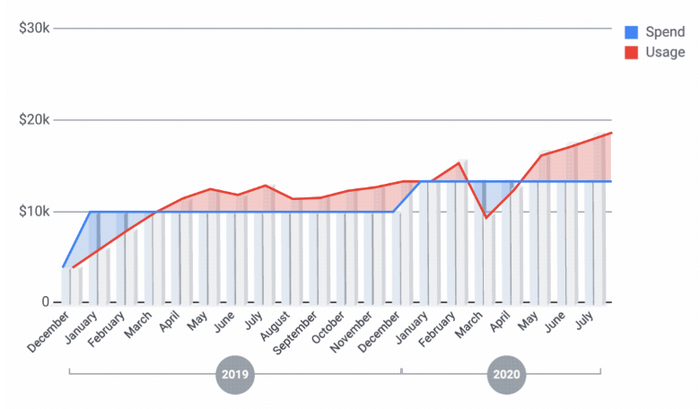Google Cloud Addresses Cost Predictability with New Storage PlanGoogle Cloud Addresses Cost Predictability with New Storage Plan
This gives customers stable pricing for storing data in Google Cloud Storage for 12-month periods.
March 6, 2019

Google Cloud Platform is tackling the thorny issue of predictable cloud costs through a new data storage pricing option that will enable customers to set the amount they will spend for cloud storage over a 12-month period.
The company’s new storage growth plan for Google Cloud Storage is designed to give enterprises and startups a way of taking advantage of cloud storage’s flexibility and bursting capabilities when needed, while ensuring they won’t be hit with surprise costs. Under the plan, customers decide how much they will spend – at least $10,000 per month – over a one-year time frame.
If the customer stores data at a cost above what they’ve committed to during the year, they aren’t charged. At the end of the 12 months, customers then can commit to their peak usage for the next 12 months. If the peak was within 30 percent of the original commitment, there’s no charge over the previous year’s overage. If the peak was more than 30 percent, then the overage is repaid over the next year.
The customer also can keep the payment plan as-is and pay for the previous year’s overage. Most customers likely will be within the 30 percent mark, so by recommitting to the program, their overage wouldn’t be charged, Chris Talbott, head of cloud storage product marketing at Google, told Channel Futures.

Google’s Chris Talbott
“The whole program is designed to allow customers to fix their costs so they can become way more predictable in terms of budgeting and forecasting their storage spend, which we’re hearing a lot about from customers — everyone from traditional enterprises to startups,” Talbott said.
The program addresses a key challenge for organizations as they move more of their workloads and data into the cloud. Companies need the amount they spend on cloud data storage to be predictable, even if the amount of data they are creating and storing is unpredictable. Flexera’s last Rightscale State of the Cloud report found that 94 percent of businesses are using the cloud in some form, and that addressing spending and optimizing costs are among the top priorities for companies.
“Unpredictable spending on cloud has become an issue for many companies,” Charles King, principal analyst with Pund-IT, told Channel Futures. “Many companies likely underestimate the impact of storage on their cloud contracts over the long term. That’s partly because storage has become a cheap commodity that most people (including many sophisticated IT users) simply take for granted.”
 In addition, “digital information continues to grow so rapidly that it’s difficult to parse just how much storage is requited to support it, especially across entire organizations,” King said.
In addition, “digital information continues to grow so rapidly that it’s difficult to parse just how much storage is requited to support it, especially across entire organizations,” King said.
Google Cloud already has programs in place for compute that drive down pricing for customers who commit to using the platform for a long term, Talbott said. Now the company is addressing the storage side.
“It makes it really simple for customers to predict their costs when they’re just paying this one fixed fee for 12 months,” he said. “But, while customers want predictability, they also want that great elasticity and flexibility that cloud provides and the ability to burst if they need to over that commitment and not have to pay for that in real time.”
As customers benefit from a more stable pricing environment, so will channel partners, according to Kyle Bassett, a partner with Arctiq, a platform-agnostic services firm that works with organizations in their modernization efforts, and partners not only with Google Cloud but also Microsoft Azure and Amazon Web Services.
A program like Google Cloud’s pricing model is “important to help us drive projects forward and meet business objectives,” Bassett told Channel Futures. “We don’t focus on straight-up resale; we are focused on delivering solutions and business value. But we need customers to be …
… successful and have a good cost model to drive the real agility and business value cloud brings.”
Cost predictability is a challenge for customers, he said.

Arctiq’s Kyle Bassett
“This is a whole new consumption model,” Bassett said. “Many customers are used to planning for long capex cycles and moving to an opex model can be challenging. We are trying to drive self-service, agility and speed. Lots of planning. Predictable workloads can be challenging when you are trying to move fast and agile.”
The new program also is good for Google Cloud as it courts more enterprise customers in hopes of growing the business and competing better against AWS, Azure and IBM Cloud, Pund-IT’s King said.
“Google’s efforts in cloud have been less effective than many of the company’s other initiatives, and has been troubled with shifts in strategy and focus,” the analyst said, adding that hiring ex-Oracle president Thomas Kurian late last year to run Google Cloud “is an effective line in the sand, at least in terms of enterprise-focused sales, but how much he will be able to move the needle remains to be seen.”
Still, the cloud market is relatively young, giving Kurian “some open road ahead of him,” he said. “But Google needs to get traction ASAP or its chances for building a commercially meaningful cloud business will begin to fade.”
Google Cloud is adding another way to reduce storage costs in the cloud. The company last year announced that its Cloud Storage Coldline – the lowest cloud storage tier – in multiple regions was now georedundant, which means another copy of the data is stored at least 100 miles away in a different region to protect against disasters and data loss. Now Google Cloud is dropping the prices of Coldline storage in regional locations by 42 percent, to as low as 4 cents per gigabyte.
About the Author
You May Also Like


